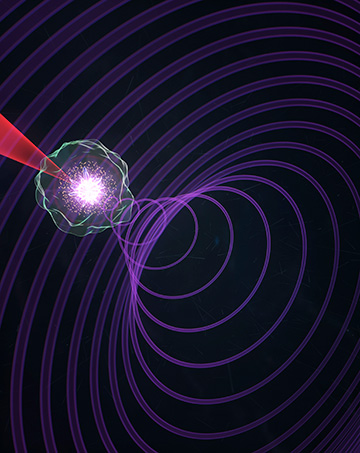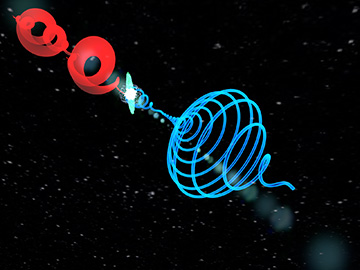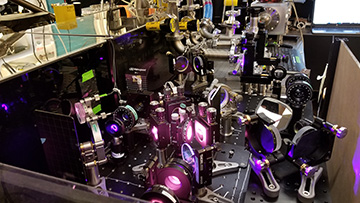
[Image: Steven Burrows, JILA–University of Colorado Boulder]
Engineers and researchers looking for new ways to put light to work have increasingly been drawn to so-called twisted light—beams that include orbital angular momentum (OAM). Also known as vortex beams, these OAM-carrying light fields offer a variety of opportunities for controlling and shaping light in optical tweezer systems, communications, microscopy and more.
Now, a team of researchers in Spain and the United States reports that it has teased a new degree of freedom from these twisted light beams: the previously un-observed property of self-torque (Science, doi: 10.1126/science.aaw9486). According to the researchers, this property—essentially manifest as rapid time variation of OAM along the light pulse—offers new opportunities for structuring and controlling light that could illuminate the behavior of matter at femtosecond and nanometer scales.
Helical phase fronts
OAM-carrying beams are characterized by twisted or helical phase fronts, which spiral in a spatially varying distribution along the beam, and by an annular or “donut-like” intensity distribution in cross-section. Such beams—first described more than a quarter of a century ago (see “Light Served with a Twist,” OPN, June 2017)—include an OAM defined as ℓℏ per photon, where ℓ is an integer multiple known as the topological charge. OAM beams are usually created using bulk optics such as spiral phase plates or Q-plates, or digital light shapers such as spatial light modulators.
The “twist” of these beams gives them some intriguing possibilities in light–matter interaction, and they’ve become sufficiently common as an object of lab study that technologists are starting to mull a variety of applications for them. Those potential applications include the rotational manipulation of microparticles in novel optical-tweezer setups. There’s even talk of using OAM modulation as a possible route to more bandwidth in capacity-constrained optical communications networks.
From OAM to self-torque
Researchers at the University of Salamanca, Spain, led by OSA student member Laura Rego and OSA member Carlos Hernández-García, realized that, in certain circumstances, vortex beams might be created in which the OAM varies not only in space but in time. Such a “self-torque” would be analogous to similar time variation of angular momentum seen or predicted in some other systems, as in the radiation reaction of moving charged particles and even in gravitational radiation near compact binary black holes.
In the case of light, Rego, Hernández-García and their collegues observed that OAM self-torque could emerge as a natural outcome of the nonlinear optical process called high-harmonic generation (HHG)—used, among other things, for creating very high energy extreme-ultraviolet (EUV) and coherent X-ray beams. In this process, the interaction of an intense laser with a cloud of molecules, such as argon gas, ionizes electrons in the gas. The electrons are then accelerated in the strong laser field, and the accelerated electrons are driven back to the parent ions, resulting in the emission of high-energy EUV or X-ray photons. HHG is a key process for creating ultrafast, attosecond pulses (see “Sources and Science of Attosecond Light,” OPN, May 2015).

The experiments combined two time-delayed vortex beams with different OAM numbers, and—via high-harmonic generation through interaction with an argon gas cell—created coherent EUV output light with time-varying OAM, or self-torque. [Image: Kevin Dorney, Kapteyn-Murnane group, JILA–University of Colorado Boulder]
The Salamanca scientists noted that under certain conditions, beams created by HHG would exhibit time-varying OAM, and thus self-torque, as a natural consequence of conservation of angular momentum. Specifically, their calculations, confirmed in numerical modeling done in partnership with researchers at Spain’s Institute of Photonic Science (ICFO), looked at what would happen if HHG were driven by two time-delayed, infrared vortex pulses.
The calculations indicated that if the OAM of the two driving beams (as measured by the integer topological charge ℓ) differed by exactly one, the resulting combined HHG radiation would be forced by the conservation law to have time-varying OAM. The amount of this self-torque would depend not only on the driving fields’ OAM content, but on the time delay and the HHG order produced. Moreover, the calculations suggested that there would be an easy way to determine whether the output beam had self-torque: an observable azimuthal “chirping” or distribution of frequencies across the beam.
Running the experiment
To put these ideas to the experimental test, the Spanish researchers teamed up with the research group of OSA Fellow and Frederic Ives Medal winner Margaret Murnane and OSA Fellow Henry Kapteyn, at JILA/University of Colorado in the United States. In experiments led by OSA student member Kevin Dorney at JILA, separate infrared pulses from an ultrafast regenerative amplifier, with time delay adjustable on femtosecond scales, were passed through spiral phase plates and other optical elements to create two OAM beams with specific topological charges. The beams were then recombined and trained on a vacuum chamber containing argon gas, resulting in HHG radiation at orders ranging from 13 to 23.
Optical table at JILA with beamline used in experiments establishing self-torque. [Image: Kevin Dorney, Kapteyn-Murnane group, JILA–University of Colorado Boulder] [Enlarge image]
The resulting HHG beams were then routed to an EUV spectrometer for analysis. The team found that the beams displayed precisely the azimuthal frequency chirp that the modeling predicted—a clear indication that the beams embodied the previously unobserved property of self-torque. And they also found that, as expected, the amount of self-torque could be controlled by tweaking the time delay between the two OAM driving pulses.
New fundamental tool?
What will this new property be useful for? Right now, the team believes this new class of beams will mainly be of laboratory interest, as a tool for “controlling magnetic, topological, and quantum excitations and for manipulating molecules and nanostructures on their natural time and length scales”—that is, nanometers and femtoseconds.
“This is the first time that anyone has predicted or even observed this new property of light,” lead-coauthor Laura Rego of the University of Salamanca said in a video released along with the paper, “so the immediate applications are not obvious.” But, she adds, “from the fundamental-science point of view, this new structural property adds a new degree of freedom to study the dynamics of the light-matter interaction.”
The other lead-coauthor, JILA’s Kevin Dorney, suggested in the same video that these “short-wavelength whirlwinds” of light might someday be applied to new forms of spectroscopy for studying chiral molecules (important, for instance, in drug design) at the nanoscale. And, he says, the self-torque beams could afford a better understanding of ultrafast and nanoscale physics that could be relevant in future device designs.

